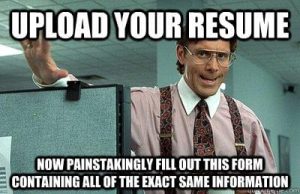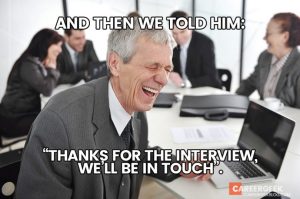
Today’s Morning Buzz is by Jenny Kosek. Connect with her on Twitter or LinkedIn.
- What I’m Reading: Cursed: An Anthology of Dark Fairy Tales
- What I’m Watching: Evil
- What I’m Listening to: The Pierces, Thirteen Tales of Love and Revenge
_____________________
The rules of recruiting have changed.
As many organizations are aware, hiring was tough pre-pandemic and is only harder now. Recruiting isn’t something that only happens when you have a job opening. It’s an ongoing, key component of your organizational success. It’s not a passive activity. It’s an all-out battle against every other employer (public and private) seeking talent.
Posting to job boards is not enough, and we need to understand the new rules of the game if we want to play on this field:
-
Your Employer Brand is Everything
This is beyond logos, taglines, and printed t-shirts. Your employer brand is how people feel about working for you and it should inspire more people to want to do so. If your employer brand is positive – you have high employee satisfaction rates, your staff referral program is strong, your retention numbers are solid – your next step is to promote all of that! Short videos, TikToks, blog posts, employee interviews, and other creative content strategies can help spread the word about the positive work culture you offer to excite new candidates to apply.
If you don’t have a positive work culture, read no further. There are no tricks you can apply to recruiting that will hide a bad culture. Glassdoor reviews, negative employees on social media, and word of mouth from your disgruntled staff will reveal all quickly enough. You need to spend time on creating a culture people want to work in before you can effectively recruit.
-
Job Posts Need to Sell (to Everyone)
Job descriptions and job posts are two different pieces of content. You don’t have to put all of the former in the latter. For your job posts, write like a human and write to sell. Robotic job posts that offer a laundry list of duties don’t excite anyone to want to do the work. The longer they get, the less candidates will read.
What do we DO in government? We make communities safer. We keep environments clean. We work hard to make the lives of our residents better, and we try to have fun while doing it. We have hard-to-find benefits like pensions and generous PTO. We make decisions and take actions that have an immediate and positive impact on the people we serve. We want to better every day. Imagine if we talked about that in a government job ad instead of “The village of ABC is accepting applications for the position of…”
While you’re at it, consider how inclusive your posts are. Avoid “s/he” and use gender-neutral terms like “the ideal candidate.” Traditionally masculine words, like “drive” or “strong,” may deter women and gender non-binary candidates from applying. Select terms like “energy” or “steady” instead. These subtle considerations can improve your applicant response by as much as 42%.
-
Post Widely But Smartly
It’s not enough to post on your website and social media pages. Seek out industry job boards, like ELGL’s, to reach a broader candidate pool. Do some research to find industry groups in the public and private sector specific to the fields you’re hiring for (for example, your communications/PIO jobs had better be on Big Shoes Network). Reach as far as possible across the internet to get your job in front of as many eyes as possible.
Still, reach wisely: think carefully about where you’re posting and who you might reach there. LinkedIn is great for knowledge workers, but a dead zone for connecting with manual laborers. Conversely, more blue-collar workers use Facebook, so don’t waste time trying to recruit your next Finance Director there. Do your homework to understand the demographics using job boards and social media platforms, and post thoughtfully. It will save you time and better reward your effort.

-
Make It Easy to Apply
Let people apply through the platforms you’re posting in and for crying out loud, don’t require a resume and a complex application form. If you’re promoting your jobs on LinkedIn, Indeed, or Facebook but not letting people apply there, you’re losing candidates. With many job seekers applying on mobile phones, multiple uploads and tedious forms can be a deal-breaker.
And if you’re thinking “We don’t want a candidate who won’t follow our directions,” then you must not really want candidates. If you’re serious about needing to fill a role, you’ll make it as easy as possible for people to connect with you about it. In a hiring climate like we currently face, candidates have plenty of options. They don’t have to play by our rules; we need to play by theirs.
-
Personal Social Media is Essential
Since hiring happens online, recruiters need to have strong social media presences to expand their reach to candidates. Having an active LinkedIn profile (and strong company page) and using Twitter to connect with others in your industry (we’re waiting for you on #localgov Twitter!) can expand your network exponentially and build a candidate pool in advance of job openings. Cultivating your personal brand will bring others in the industry to you, making it incredibly easy for you to refer contacts or followers to apply for your jobs.

-
Post and Pray is Not Okay
While digital methods are the biggest tool in the recruiting toolbox, “post and pray” cannot be your only recruiting method. That is, you can’t expect to fill all positions online. You must get outside of the virtual world to promote your employer brand and build recruiting contacts. Attend job fairs, set up a booth at city events, and establish your presence at professional networking events in your area. Try the old-fashioned route: reserve a billboard, hang a banner, or put “now hiring” posters throughout the businesses in your key commercial corridors. If you’re facing hiring challenges (as we all are) there is no method of connecting with candidates that should be off the table. Get out of the “HR administrator” mindset and think of yourself as a salesperson for opportunities on your team. Salespeople are relentless, and recruiters need to be, too.
-
It is Okay to Poach
Government seems uncomfortable with the idea of poaching, or directly recruiting candidates that work in competitive organizations. While local government is incredibly collaborative, we are all competing for talent, and we need to act like it. Do you want the best talent in local government on your team? If so, they’re probably already working in another municipality, so why not try to move them to yours? You’ll likely have to put all your cards on the table here – experienced professionals in other municipalities can and likely will play hardball with salary and benefits – but if the result is getting the best person in the industry at your organization, isn’t it worth it?

-
Treat Candidates Well
After decades of automating hiring, the HR industry is turning back to the “human” side of human resources. A human being’s hope, livelihood, and future is being put in your organization’s hands with each click of “apply.” Remember, the candidate who may not fit your current opening might fit a future opening. If they don’t, they will still talk to their contacts about their experience in your hiring process. If it’s cold and indifferent, they’ll remember. If it’s human-centered, compassionate, and respectful, they’ll also remember – and they’ll become ambassadors for your organization.
Successfully recruiting in this strange new age is about being strategic, creative, and tireless. There’s no magic wand that can improve your recruitment outcomes. It takes a comprehensive and ongoing effort to promote your organization, sell your opportunities, and connect with candidates. Yes, it’s a lot of work. But it’s the only way to compete and win the hiring game.
